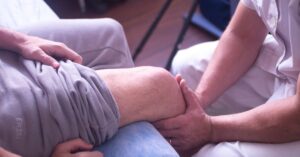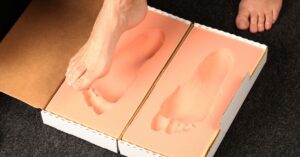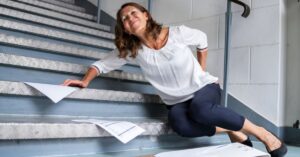Definition of a herniated disc
A herniated disc occurs when the cushioning between the vertebrae in the spine protrudes or bulges out of its normal position, putting pressure on nearby nerves. This can result in pain, numbness, or weakness in the affected area. Optimum Alberta Back and Neck Rehab specialises in advanced non-invasive treatments for herniated discs and traditional treatments focusing on physical therapy and rehabilitation to help you find relief from their symptoms and improve your overall mobility and function.
Importance of physical therapy in recovery
Lumbar disc herniation can cause significant pain and discomfort, making everyday activities difficult. Optimum Alberta Back and Neck Rehab emphasises the importance of physical therapy in the recovery process. Through targeted exercise therapy, electrical stimulation, and TENS, physical therapy can help reduce pain and muscle spasms associated with lumbar disc herniation.
In addition to easing symptoms, physical therapy plays a crucial role in aiding the recovery process. It focuses on strengthening core muscles and improving body mechanics to prevent future herniation. Physical therapy can enhance overall function and mobility by targeting specific muscle groups and addressing imbalances.
At Optimum Alberta Back and Neck Rehab, our approach to physical therapy is tailored to each individual’s unique needs and goals, providing a comprehensive and personalised treatment plan. By incorporating physical therapy into their recovery, patients can experience significant improvements in their symptoms and overall quality of life while reducing the risk of future complications.
An explanation of herniated discs
At Optimum Alberta Back and Neck Rehab, we understand the importance of educating our patients about common spinal conditions, such as herniated discs. A herniated disc occurs when the soft inner core of a spinal disc pushes through the tough outer layer, causing pain, weakness, or numbness in the arms or legs. It is often the result of ageing, wear and tear, or sudden injury to the spine. Understanding the causes, symptoms, and treatment options for herniated discs is crucial for effective management and prevention of further complications.
Anatomy of the spinal disc
The spinal disc is a crucial spine component, providing support and flexibility. It is composed of vertebrae, intervertebral discs, and surrounding tissues. The vertebrae are the individual bones of the spine, while the intervertebral discs are the soft, cushion-like structures between each vertebra. These discs act as shock absorbers, absorbing the impact of everyday movements and activities, allowing for spine flexibility and movement.
The intervertebral discs have two main parts: the nucleus pulposus and the annulus fibrosus. The nucleus pulposus is the disc’s inner core, made of a gel-like substance that provides flexibility and cushioning. The annulus fibrosus is the rigid outer ring of the disc, giving structure and resisting compression.
Key components of the spinal disc include water, collagen, and proteoglycans. Water helps to maintain the disc’s height and flexibility, while collagen and proteoglycans provide strength and support. Together, these components provide support and mobility to the spine, allowing for everyday movements and activities. Understanding the structure and composition of the spinal disc is crucial for maintaining spinal health and preventing injuries. For more information on back and neck health, visit Optimum Alberta Back and Neck Rehab.
Potential causes and potential risk factors
Herniated discs, also known as slipped or ruptured discs, are caused by various factors. Natural age-related degeneration of the spinal discs is a common cause, as the discs lose water content and become less flexible over time. Improper lifting techniques can also lead to herniated discs, especially when lifting heavy objects while twisting the spine. Excess body weight puts added pressure on the spine, increasing the risk of disc herniation. Genetics can also play a role, as some people may inherit a predisposition for weakened spinal discs. Certain occupations that involve repetitive lifting, bending, or twisting movements also increase the risk of developing herniated discs. Smoking is another risk factor, as it can lead to a reduction in the oxygen supply to the spinal discs, making them more susceptible to damage. At Optimum Alberta Back and Neck Rehab, we understand the various causes and risk factors associated with herniated discs and provide personalised treatment plans to help alleviate symptoms and improve spinal health.
Symptoms and diagnosis
A herniated disk can cause various symptoms, including pain, tingling, numbness, and weakness in the affected area. Patients may also experience shooting pain down the arms or legs, depending on the location of the herniation.
Physical therapists at Optimum Alberta Back and Neck Rehab are trained to conduct thorough evaluations to diagnose a herniated disk. These evaluations may include assessing the patient’s range of motion, muscle strength, and sensory perception. The therapist will also look for specific orthopaedic signs indicating a herniated disk, such as increased pain or radiating symptoms during particular movements or positions.
If more severe problems are identified, the physical therapist will collaborate with a physician or surgeon for further diagnostic testing, such as an MRI. This specialised imaging can provide a detailed view of the spine and help to confirm the diagnosis of a herniated disk. Optimum Alberta Back and Neck Rehab patients can receive a comprehensive and personalised approach to managing their herniated disk by working closely with healthcare professionals.
Conservative Treatment Options for Herniated Discs
At Optimum Alberta Back and Neck Rehab, we understand the debilitating effects of a herniated disc. Fortunately, there are conservative treatment options that can alleviate pain and improve mobility without the need for surgery. Our clinic offers a range of non-invasive therapies that focus on reducing inflammation, relieving pressure on the affected disc, and strengthening the surrounding muscles to support the spine. Whether it’s through chiropractic care, physical therapy, or spinal decompression, our team is dedicated to helping patients find relief and improve their quality of life. With a personalised treatment plan tailored to each individual’s needs, we aim to manage herniated disc symptoms effectively and promote long-term healing. Optimum Alberta Back and Neck Rehab is here to provide the care and support you need if you’re seeking a non-surgical approach to address a herniated disc.
Rest and limited activity
Rest and limited activity are crucial components of your recovery plan at Optimum Alberta Back and Neck Rehab. You can reduce strain and aid healing by allowing your spine to rest. It’s important to avoid activities that exacerbate your pain and, instead, follow your physical therapist’s recommendations for limited movement and rest periods.
During this time, it’s essential to prioritise proper body mechanics and avoid heavy lifting to prevent further injury. Your physical therapist will guide you on how to move and position your body in a way that supports healing. Taking the time to rest and engage in limited activity will contribute to the overall success of your recovery.
At Optimum Alberta Back and Neck Rehab, our focus on rest and limited activity as part of a comprehensive treatment plan is designed to support the healing process and restore your back and neck health. Trust in our experts’ recommendations and prioritise rest and limited activity to maximise the benefits of your treatment.
Cold therapy for inflammation reduction
Cold therapy is a great way to reduce inflammation in the body. To start, apply ice packs or cold compresses to the affected area. This will help inhibit circulation and lessen pain and inflammation caused by muscle spasms. Limiting each hard therapy session to 15-20 minutes is essential to avoid skin damage.
At Optimum Alberta Back and Neck Rehab, we recommend using cold therapy as part of a comprehensive treatment plan, which may also include physical therapy. It’s essential to address the root cause of the inflammation. While cold therapy can help reduce symptoms, working with a healthcare professional to develop a treatment plan that addresses the underlying issue is essential.
Remember, cold therapy is just one component of an effective treatment plan for inflammation reduction. It should be used with other treatments, such as physical therapy, to achieve the best results.
Role of Physical Therapy in Recovery from a Herniated Disc
If you’re suffering from a herniated disc, you may be wondering about the role of physical therapy in your recovery. At Optimum Alberta Back and Neck Rehab, we understand the importance of physical therapy in treating herniated discs and helping patients regain function and reduce pain. Our experienced physical therapists are skilled in designing individualised treatment plans to address each patient’s needs. Physical therapy is crucial in promoting healing and preventing future injuries, from targeted exercises and stretches to manual therapy and education on proper body mechanics. Learn more about the critical role of physical therapy in recovering from a herniated disc at Optimum Alberta Back and Neck Rehab.
Goals of physical therapy
Physical therapy at Optimum Alberta Back and Neck Rehab aims to achieve several vital goals for managing herniated disc symptoms. The primary goal is to reduce pain through targeted exercises and techniques. Additionally, physical therapy focuses on strengthening the supporting muscles in the back and neck to provide better stability and support for the spine. Another important goal is to enhance flexibility in the affected areas, which can help reduce stiffness and improve overall mobility.
In addition to symptom management, physical therapy plays a crucial role in developing better body mechanics to prevent future herniation. Therapists work with patients to improve posture, body alignment, and proper lifting techniques to reduce re-injury risk.
It’s essential to consult a doctor before starting physical therapy to rule out other potential causes and ensure the best treatment for your condition. Our Optimum Alberta Back and Neck Rehab team collaborates with physicians to create personalised treatment plans that align with each patient’s needs and goals. Let us help you achieve optimal function and well-being through our comprehensive physical therapy services.
Benefits of physical therapy over surgery
When it comes to treating a herniated disc, opting for physical therapy at Optimum Alberta Back and Neck Rehab can offer numerous benefits over surgery. Our non-invasive approach focuses on holistic methods to address the root cause of the issue, leading to a shorter recovery time and long-term benefits of maintaining a healthy spine.
Our physical therapists create customised treatment plans tailored to each patient’s needs. These plans may include targeted exercises to strengthen the affected area and improve flexibility. In addition, we offer alternative treatments such as manual therapy, acupuncture, and spinal decompression to complement the rehabilitation process.
By choosing physical therapy over surgery, patients can avoid the risks and complications associated with invasive procedures. They can also experience a quicker recovery and return to their daily activities. Furthermore, physical therapy promotes overall wellness and helps prevent future spine-related problems.
With a focus on a non-invasive approach, shorter recovery time, customised treatment, targeted exercises, and alternative treatments, physical therapy at Optimum Alberta Back and Neck Rehab offers a comprehensive and effective solution for herniated discs.
Common Physical Therapy Techniques for Herniated Discs
Herniated discs can be a source of significant pain and discomfort for many individuals. At Optimum Alberta Back and Neck Rehab, we offer a variety of physical therapy techniques to help alleviate the symptoms and improve the function of those suffering from herniated discs. From manual therapy and spinal manipulation to specific exercises and stretches, our skilled therapists provide personalised care to address each patient’s unique needs. Our goal is to help patients regain mobility and reduce pain without depending on medications by focusing on strengthening and stabilising the affected area. Our approach to physical therapy for herniated discs aims to improve our patient’s overall function and quality of life.
Manual therapy to relieve muscle spasms and improve range of motion
Manual therapy techniques, such as traction and mobilisation, can offer significant relief for individuals suffering from muscle spasms and limited range of motion due to herniated discs. At Optimum Alberta Back and Neck Rehab, our skilled therapists utilise these manual approaches to effectively decompress spinal structures, enhance joint mobility, and alleviate pressure on affected discs. By doing so, we help to improve overall function and reduce the accompanying pain.
Traction, for instance, involves gently stretching the spine to alleviate pressure on the discs and nerves, while mobilisation focuses on restoring normal joint movement and releasing muscle tension. Both techniques relieve muscle spasms and improve range of motion, promoting a healthier, pain-free state for our patients. In conjunction with other modalities and therapies, manual therapy serves as an essential component of our comprehensive approach to treating herniated discs and their attendant symptoms.
Make an appointment today!
To make an appointment at Optimum Alberta Back and Neck Rehab today, call our office at 403-234-0040 or book online. When making your appointment, be prepared to provide your name, contact information, preferred date and time, and the reason for your visit. Our friendly staff will be happy to assist you in scheduling a convenient appointment that suits your schedule. Whether you have neck pain, back pain, or any other musculoskeletal issue, our experienced professionals are here to help. Don’t delay getting the relief you need – contact us today to make an appointment and start your journey towards a healthier, pain-free life.
Meta Description:
1. Physical therapy plays a crucial role in recovering from a herniated disc. Discover how this therapy can help you regain strength and reduce pain in this informative guide.




